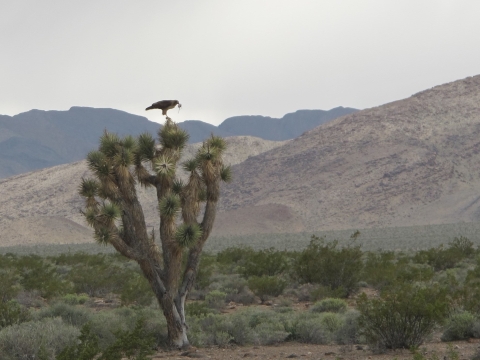The bright lights and flashing billboards faded into a warm, orange glow as I headed north on US-95 out of Las Vegas and into Nevada’s desert. While many tourists come to the city to experience its casinos and lavish hotels, the goal of my trip was to leave that world behind, trading wild nights for complete wilderness.
Less than an hour from the Vegas strip is one of the largest, most pristine pieces of desert remaining in the U.S.
Desert National Wildlife Refuge managed by the U.S. Fish and Wildlife Service, is the largest wildlife refuge in the lower 48 at 1.6 million acres—twice the size of the state of Rhode Island.
It encompasses six major mountain ranges and the landscape transitions from snow-covered mountain peaks to sand dunes and from mesquite covered valleys to forests of white and ponderosa pines.
More than 400 species of birds, mammals, amphibians and reptiles find sanctuary in this quiet landscape uninterrupted by paved roads or buildings.
The desert refuge is a rare gem in a rapidly-expanding urban area. Originally established by Franklin Roosevelt in 1936 as habitat for desert bighorn sheep, the refuge has expanded upon its conservation purpose over the years. Today, the refuge provides Nevadans and tourists with access to relatively untouched, open desert lands for hiking, camping, birdwatching, photography, hunting and many other activities.
NEVADA’S LOVE FOR THE OUTDOORS
Las Vegas has become a jumping off point for outdoor enthusiasts making recreation an important part of Nevada’s economic mix. In a report released by the Outdoor Industry Association, outdoor recreation in Nevada generated $12.6 billion in consumer spending and 87,000 direct jobs. It’s not just tourists generating the numbers. At least 57 percent of Nevadans are taking advantage of the recreational opportunities too.
“This area offers world class recreation,” said Jennifer Heroux, chief of visitor services for Desert National Wildlife Refuge Complex. “Everyone is looking to get outside. The scope of what you can do and see is limitless.”
Many recreational areas around Las Vegas, such as Red Rock managed by the Bureau of Land Management, are already “over-loved” as Heroux puts it. But just beyond the city’s limits, the refuge offers solitude. “The refuge has room for people to get beyond the crowds and explore open space,” she said.
THE DESERT EXPERIENCE
Just past sunrise, I joined Jennifer, two local REI employees and Jose Witt, Southern Nevada director for Friends of Nevada Wilderness for a daytrip through the refuge.
The plan: to drive the 72-mile length of Alamo Road – the main road that runs north to south through the refuge – to see wildlife, recreational opportunities and reminders of the refuge’s rich history.
As a new member of the Pacific Southwest Region’s external affairs team, this was my first visit to a National Wildlife Refuge, and I had a feeling it would be a memorable experience.
The northern end of Alamo Road starts adjacent to Pahranagat National Wildlife Refuge, just off Highway 93 near Alamo, Nevada. Road conditions are as unpredictable as the desert weather, and even in good weather the drive takes approximately five hours. Jose, however, smoothly navigated a large truck, lovingly named Sugar, along the gravel road.
“I have been coming out to the refuge since I was a teenager,” Witt said. “Now I know these roads well, but my first time out here, I nearly ran out of gas.”
Witt has spent hundreds of hours on the refuge and can point out man-made changes in the landscape that need to be repaired, such as tire tracks on embankments that cause erosion; fixes that partners, like Friends of the Nevada Wilderness, can help carry out.
During our trip, we saw beautiful landscapes that ranged from the snow-capped Sheep Mountain Range to desert valleys sprinkled with wildflowers in shades of purple and yellow. A morning hike allowed us to see petroglyphs that depicted desert bighorn sheep.
Lunchtime was spent hiking to the top of white sand dunes that sat next to a large, dry lake bed.
And in the afternoon, we stretched our legs during a short rainstorm to find a cave with a ceiling blackened from years of campfires and an agave roasting pit used to cook the sweet hearts of the agave plant—reminders of the rich cultural history and value of this land to the Southern Paiute tribes.
Wildlife was all around us but well camouflaged. Sharp eyes among the group helped us see a hawk enjoying a rodent lunch from the top of a Joshua tree and lizards sunning themselves on rocks.
The one thing we didn’t see was another person.
“That is what makes the refuge different from other local public lands: the experience of remoteness without being that remote,” said Ashley Lee, outdoor programs and outreach market coordinator for REI’s Las Vegas market. Throughout the day, Ashley and her colleague evaluated recreational opportunities at the refuge, taking note of potential hiking spots that could be recommended to REI members and required skill levels that would be needed to do the hike safely.
While we covered a lot of ground, we only saw a sliver of what the refuge offers. Throughout the day, Jennifer and Jose told us stories of how people are using the refuge. One man mountain biked the length of Alamo Road over the course of three days. Jeep clubs regularly tour the refuge roads. Photographers trek across the rocky trails to get magnificent shots of wildlife and desert landscapes. Off Mormon Well Road, backpackers, hikers and horseback riders visit walls of fossils left behind from when this land was once covered by an inland sea. In November and December, desert bighorn sheep hunting is allowed on the refuge. Altogether, 70,000 people visit the refuge every year, and that number is growing.
“Fall and spring are the best times to come to the refuge,” said Amy Sprunger, refuge manager for Desert NWR. “Birdwatching and hiking are the two top activities we see people doing out here, but we also see people coming to camp.”
Desert Pass is the sole campground on the refuge. Located approximately an hour and a half down a dirt road from the refuge’s Visitor’s Center on Corn Creek Road, it has six sites with tent pads, fire rings and picnic tables, and two primitive restrooms.
“Desert Pass is a beautiful area with ponderosa pines,” says Sprunger. “You certainly could see mule deer and birds that come to the spring in that area.” Campsites are fee-free and are on a first-come, first-served basis.
Beyond the campground, car camping and backcountry camping is permitted throughout the refuge. “One thing that I love about the refuge is that you can camp anywhere,” said Witt. He recommends a little spot at the end of Dead Horse Road where dark skies and views of the Sheep Mountain Range are endless. “Last year, my wife and I hiked to some remote canyons where it seemed as though no humans had ever been,” he said. “Doubtful of course, but only pristine landscapes can give one that feeling.”
For experienced outdoor enthusiasts seeking solitude, this is it.
“We get a lot of travelers who want to get off the beaten path and have a weekend experience,” said Lee. “The first thing I always tell people about Desert (refuge) is that you need a high-clearance vehicle. A Honda Civic will get stuck out there.”
In addition to a vehicle with clearance, packing enough water and fuel is essential, as is finding a way to pack your waste out of the sensitive desert landscape. These criteria don’t tend to scare off too many people. In 2016 and 2017, the campground was full on Labor Day weekend.
For people who want to get a taste of what the refuge offers without “roughing it,” the visitor’s center off Corn Creek Road is an excellent option.
Here, people can interact with indoor exhibits or walk along short paths where birds, reptiles, endangered fish and beautiful vistas can be spotted without having to leave paved roads.
“When I’m out here, it gives me a real feeling of freedom,” said Sprunger. “I think the name ‘Desert’ belies the beauty of this land that we protect and conserve. Desert (refuge) is an experience.”




